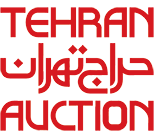The coming into vogue of the ‘still life’ as a fixed classical composition was one of the most important influences of the academy of Kamal-ol-Molk on Iranian art. The ‘still life’ began gradually appearing in the 16th century AD in the paintings of the northern European Renaissance and in the works of the baroque painters. Nevertheless it wasn’t until the advent of the Iranian naturalists, through the efforts of Kamal-ol-Molk and his students, that the ‘still life’ made an appearance in Iranian painting, and it only did so through the pioneering endeavors of Esmail Ashtiani, one of the most important of Kamal-ol-Molk’s students. This development was indicative of the Iranian painter’s search for new subject matter other than the flowers and birds of the Safavid and Zand eras. In this painting Ashtiani arranges traditional Iranian objects in a classical composition and in a nod to the old Masters he names the painting ‘Minimum Practice.’
Esmail Ashtiani learned the fundamentals of art at the school of ‘Industrial Design’ under Kamal-ol-Molk where, through his diligence, he was able to complete a 5-year course of study in only 3 years. He became a professor in 1917 and went on to be selected as the dean’s assistant. After Kamal-ol-Molk’s retirement in 1928, Ashtiani became the dean of the school. During his time as dean, Ashtiani founded the art library and added many new subjects to the syllabus: miniature composition, gilding, art history, the rules of perspective and more. He remained the head of the school even during his trip to Europe in 1930. When Ashtiani returned to Tehran, he taught in the school of literature and also gave graduate classes at the academy. His services to Iran in education and culture were recognized in 1946 when he received the highest award in the arts from the Supreme Council of Culture.
Ashtiani was a naturalist and a follower of Kamal-ol-Molk who painted most of his canvases directly from nature or using live models. His exceptional skills at drawing and coordinating colors along with his poetic zeal are some of the outstanding features of his work. He played a major role in consolidating the positions of naturalism and realism in Iranian painting. He refused to follow the popular trends of many of the painters of his generation who chose decorative, aristocratic and monarchial subject matter; instead he chose scenes from everyday life, such as people in the street and the Bazaar, and, of course, scenes from nature. Among his well-known works we can name; ‘Self Portrait,’ ‘The Scribe,’ ‘Behlool Asleep,’ ‘The Accordion Player,’ ‘The Wounded Bird,, ‘Hafez’s Dream’ and ‘The Inn.

